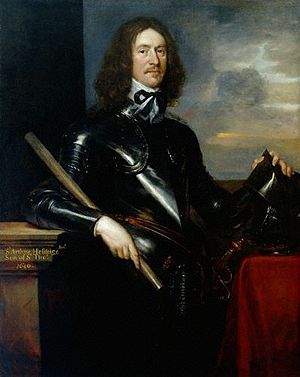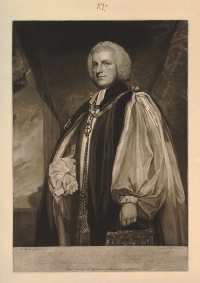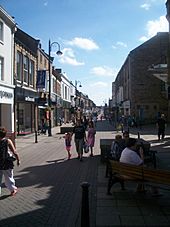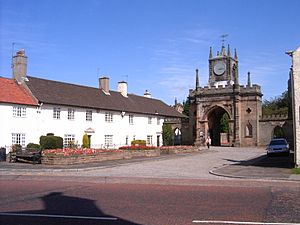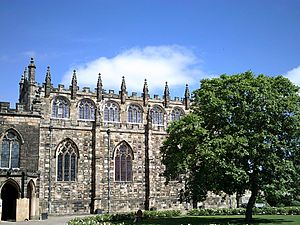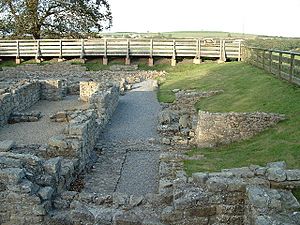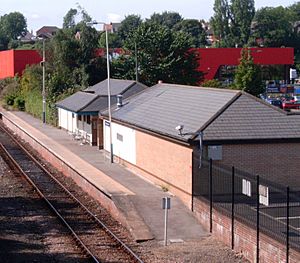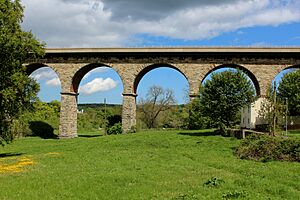Bishop Auckland facts for kids
Quick facts for kids Bishop Auckland |
|
|---|---|
| Town | |
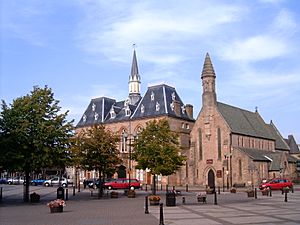 Bishop Auckland Town Hall |
|
| Population • Civil parish |
(2011 census) 16,276 |
| • Town | 24,908 |
| • Built-up area | 26,050 |
| OS grid reference | NZ208294 |
| • London | 227 mi (365 km) SbE |
| Civil parish |
|
| Unitary authority |
|
| Ceremonial county | |
| Region | |
| Country | England |
| Sovereign state | United Kingdom |
| Post town | BISHOP AUCKLAND |
| Postcode district | DL14 |
| Dialling code | 01388 |
| Police | Durham |
| Fire | County Durham and Darlington |
| Ambulance | North East |
| EU Parliament | North East England |
| UK Parliament |
|
Bishop Auckland is a busy market town in County Durham, England. It sits where two rivers meet: the River Wear and the River Gaunless. The town is about 12 miles (19 km) northwest of Darlington and 12 miles (19 km) southwest of Durham.
The town's name comes from its long history with the Bishops of Durham. They had a hunting lodge here, which later became Auckland Castle. This castle was once the main home for the Bishops of Durham. Later, during the Industrial Revolution, Bishop Auckland grew very fast. This was because coal mining became the biggest industry. Today, manufacturing is the town's largest industry.
Since 2009, Durham County Council has been the local government for Bishop Auckland. The town is also part of the Bishop Auckland area for the UK Parliament. It is twinned with Ivry-sur-Seine in France.
Contents
- History of Bishop Auckland
- Economy and Tourism
- How Bishop Auckland is Governed
- Geography of Bishop Auckland
- People of Bishop Auckland
- Important Landmarks
- Getting Around Bishop Auckland
- Schools and Learning
- Public Services
- Religion in Bishop Auckland
- Sports in Bishop Auckland
- Famous People from Bishop Auckland
- Climate
History of Bishop Auckland
What's in a Name?
The town was first called Alclit a long time ago. The name Auckland is also used for nearby places like St Helen Auckland and West Auckland. The word 'Bishop' was added to the town's name because it was on land owned by the Bishop of Durham. This helped people tell it apart from other 'Auckland' places.
The River Gaunless has a name that comes from a Norse word meaning 'useless'. People think this is because the river wasn't strong enough to power mills, support many fish, or create good farmland.
Some people think 'Auckland' might come from an old language called Cumbric, meaning "cliff on the Clyde." They believe 'Clyde' might have been the old name for the River Gaunless. Another idea is that 'Auckland' comes from old English or Norse words for 'oak' and 'land', meaning it was a place with lots of oak trees.
Early Days of the Town
The first time Bishop Auckland was mentioned in writing was around 1000 AD. It was land given to the Earl of Northumberland. In 1020, King Canute gave it as a gift to the Bishop of Durham. But there was likely a village here much earlier. There's proof of a church in South Church from the 600s.
The Romans also had a look-out spot where Auckland Castle is now. They even had a 10-acre (0.040 km2) fort nearby at Binchester. People have also found tools and signs of settlements from the Iron Age, Bronze Age, Neolithic, and Mesolithic times around the town.
The Bishops of Durham
A big part of Bishop Auckland's history is linked to the Bishops of Durham. In 1083, Bishop William de St-Calais sent some church leaders to settle here. They started a special church. Around 1183, Bishop Pudsey built a large house in the town. This house was later turned into a castle by Bishop Bek. He liked the town because it was close to good hunting grounds.
Bishop Bek also ordered the building of the Church of St Andrew in South Church, which you can still see today. This church also had a school. The school later moved to the castle grounds but closed in the 1500s.
The school reopened in 1604, thanks to King James I. It was called the Free Grammar School of King James, and it's the school known today as King James I Academy.
King Charles I visited the town three times. His last visit in 1647 was as a prisoner, not a guest. After the English Civil War, Auckland Castle was sold and partly pulled down. But when the monarchy returned, the new bishop, John Cosin, rebuilt the castle. He turned the old banqueting hall into the beautiful St Peter's Chapel that you can see now.
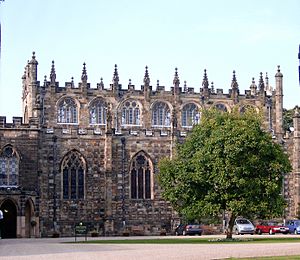
In 2012, Jonathan Ruffer bought Auckland Castle and its amazing art collection. The castle reopened in November 2019 after a huge restoration project. It's now a major visitor attraction.
The Industrial Revolution
By 1801, Bishop Auckland had about 1,861 people. There wasn't much trade besides weaving. Coal mining had been around since 1183, but it was hard to move the coal. This all changed when railways arrived in the early 1800s. Railways made it easy to transport coal to the coast and then onto ships. This led to a huge growth in coal mining.
Around this time, Bishop Shute Barrington used money from lead mining to open many schools, including Bishop Barrington School in 1810. This school even allowed girls to attend!
By 1851, the town's population had more than doubled to 5,112, with many people working in coal mines and ironworks. By 1891, it had doubled again. The town also became an important railway hub, moving coal and other minerals.
Industrial Decline
In the early 1900s, coal mining started to slow down as coal ran out. By the late 1920s, many people were unemployed. The Great Depression made things even worse, with unemployment reaching 60% in 1932. World War II helped the coal industry for a short time, but after the war, the decline continued. The last deep coal mine in the area closed in 1968.
The railways also became smaller. Shildon's Wagon works, which made railway engines, closed in 1984, causing many job losses. Today, Bishop Auckland still faces challenges with unemployment.
Economy and Tourism
In the past, coal mining was the biggest industry in Bishop Auckland. But after the mines closed, manufacturing became the largest employer.
The town also used to have a very strong shopping area. People from smaller towns came to shop here. However, with the decline of mining and the rise of big shopping centers like the MetroCentre, the town's shops have faced difficulties.
To help the town, many projects have started. In 2015, Bishop Auckland became a "Heritage Action Zone." This means there's a 5-year plan to improve the town and its economy through tourism and its history. The town also received money from a new "Towns Fund" in 2019 to help improve industrial areas.
Building Tourism in Bishop Auckland
Many people believe that the reopening of Auckland Castle will help Bishop Auckland become a popular tourist spot. The castle reopened in November 2019 after a huge restoration. This project, called the Auckland Project, is bringing many new attractions to the town.
When the castle reopened, a new 35-meter-high tower was built as a visitor center. The inside of the castle has been beautifully restored. There are also new attractions like the Mining Art Gallery, which shows art by miners.
Another exciting attraction is Kynren, a large open-air show with 1,000 performers. It tells the history of England and is located across the River Wear from the castle. The Bishop Trevor Gallery at the castle also displays famous artworks.
In the future, there will be even more attractions, including a Spanish art display, a Faith Museum, and new restaurants. The goal is to make Bishop Auckland a place where people want to stay for a few days, creating many new jobs for local people.
How Bishop Auckland is Governed
Past Governance
For a long time, the Bishop of Durham had special powers. The county was like a small kingdom under England's protection. The Bishop could raise an army, make his own coins, and collect taxes. He was like a ruler, as long as he stayed loyal to the King of England. This was important because County Durham was a "buffer state" between England and Scotland.
The Bishops of Durham lost most of their special powers in 1836.
Modern Governance
In 1894, the Bishop Auckland Urban District Council was created to govern the town. In 2007, a new town council was set up. Then, in 2009, Durham County Council became the single local authority for the whole of County Durham.
Bishop Auckland is part of the Bishop Auckland parliamentary constituency. This means people in the town vote for a Member of Parliament (MP) to represent them in Westminster.
Bishop Auckland Town Hall
The Town Hall is a beautiful "Gothic style" Victorian building in the town's market place. It's a very important historic building. After being almost torn down in the 1980s, it was fully restored in the early 1990s. Today, it has the town's main public library, a theatre, an art gallery, a tourist information center, and a café-bar.
Geography of Bishop Auckland
Bishop Auckland is located at 54°39′36″N 1°40′48″W / 54.66000°N 1.68000°W on the Durham coalfield. It sits in the valley where the River Wear and the River Gaunless meet. The town is about 100 metres (330 ft) above sea level. It is surrounded by hills that are between 150 metres (490 ft) and 220 metres (720 ft) high.
The town is about 12 miles (19 km) northwest of Darlington and 12 miles (19 km) southwest of Durham. You can get to Bishop Auckland by train at Bishop Auckland railway station. The town is not directly on any major motorways.
Some of the areas within Bishop Auckland include Cockton Hill, Woodhouse Close, and Henknowle. Nearby villages like South Church, Tindale Crescent, St Helen Auckland, and West Auckland have now grown into the town.
 |
Escomb (village) | Willington (town) | Spennymoor (town) |  |
| Toft Hill (village) | Coundon (village) | |||
| St Helen Auckland (suburb/village) | Tindale Crescent (suburb/village) | Shildon (town) |
People of Bishop Auckland
According to the 2001 census, Bishop Auckland had a population of 24,392 people. Most homes are terraced or semi-detached houses. The age groups in Bishop Auckland are similar to the rest of County Durham and England.
Most people in Bishop Auckland identify as Christian. The town has a smaller number of people born outside the UK compared to the national average.

Important Landmarks
Bishop Auckland has many important historic buildings. Auckland Castle and its grounds alone have seven buildings that are listed as Grade I, meaning they are very important. Other Grade I listed buildings include Escomb Saxon Church, St Andrew's parish church, St Helen's church, and the old Bishop Skirlaw bridge. The Town Hall and the Victorian railway viaduct are also notable.
Auckland Castle
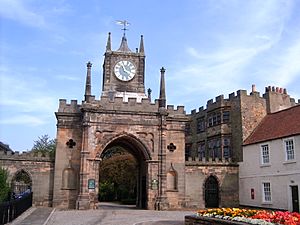
Auckland Castle was the official home of the Bishop of Durham for many years. It started as a hunting lodge for the bishops. The castle is surrounded by 800 acres (3.2 km2) of parkland, which was once used for hunting and is now open to everyone.
Inside the castle's long dining room, you can see 12 amazing 17th-century paintings of Jacob and his 12 sons by Francisco de Zurbarán. These paintings were saved by Bishop Trevor in 1756.
Auckland Castle is also mentioned in Lewis Carroll's story "A Legend of Scotland." As mentioned, the castle reopened in November 2019 after a huge restoration. This project is making the town a major tourist spot.
Binchester Roman Fort
The old Roman road called Dere Street goes right through Bishop Auckland. It leads to the nearby Roman Fort at Binchester. This fort, called Vinovia by the Romans, has one of the best-preserved Roman bath houses in the country. Bishop Auckland's main shopping street, Newgate Street, follows the path of this old Roman road.
Getting Around Bishop Auckland
Bishop Auckland has strong links to the start of railways. The first railway route from Stockton to Darlington passed through nearby West Auckland in 1825.
Today, Bishop Auckland railway station still has train services. It's the end of the Tees Valley line. Since 2010, it has also reconnected with the Weardale Railway, which takes passengers further up the valley.
The closest airport is Teesside Airport, about 19 miles (31 km) away. The nearest major road is the A1(M), about 8 miles (13 km) away.
The town also has a bus station with many routes that serve the town and surrounding areas.
Newton Cap Viaduct
The town has a beautiful Victorian railway viaduct called Newton Cap Viaduct. It crosses the River Wear and is 105 feet (32 m) high. From the viaduct, you can see great views of the countryside, Auckland Castle, and the Town Hall. It was built in 1857 for a railway line. The railway closed in 1968, but in 1995, the viaduct was changed so cars could use it. This helped ease traffic on the old, narrow Bishop Skirlaw bridge below.
On the north side of the bridge is Eleven Arches Flatts Farm, which is where the historical performance Kynren takes place.
Schools and Learning
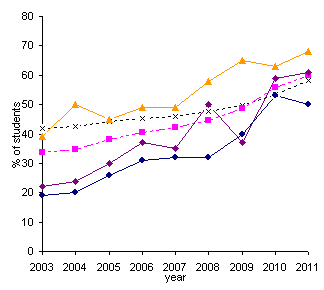
Legend Bishop Barrington Academy King James I Academy St John's Catholic School National average LEA average
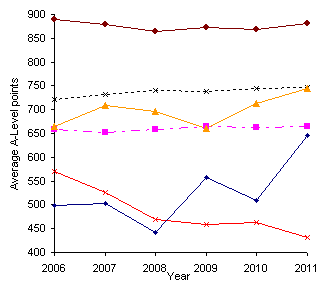
Legend Queen Elizabeth Sixth Form College King James I Academy St John's Catholic School Bishop Auckland College National average LEA average
Bishop Auckland has three secondary schools: St John's Catholic School, The Bishop Barrington Academy, and King James I Academy. The town also has Bishop Auckland College, which offers further and higher education courses. Bishop Barrington School was founded in 1810, and King James I Academy in 1604.
For students who need extra help, Evergreen Primary School provides special educational needs support.
Durham University also has a special center in Bishop Auckland called the Zurbarán Centre for Spanish and Latin American Art. Here, students can study for advanced degrees.
Public Services
Healthcare
Like the rest of the UK, Bishop Auckland has healthcare services through the National Health Service (NHS). The town has its own hospital, Bishop Auckland General Hospital, which has 286 beds. It specializes in routine surgery. In 2009, its Accident and Emergency department was replaced with an "Urgent Care Centre."
Other nearby hospitals include Darlington Memorial Hospital and University Hospital of North Durham. All these hospitals are run by the County Durham and Darlington NHS Foundation Trust. The local ambulance service is the North East Ambulance Service.
Utilities
Northumbrian Water manages Bishop Auckland's water and sewerage. The town gets its water from Burnhope Reservoir through the Wear Valley water treatment works. The electricity for the area is provided by NEDL.
Religion in Bishop Auckland
Bishop Auckland is part of the Anglican Diocese of Durham. The diocese's main offices are at Auckland Castle. For Roman Catholics, the town is in the Hexham and Newcastle Diocese. There is also a Baptist church in Bishop Auckland.
Important Churches
The town has three churches that are listed as Grade I buildings: the Church of St Helen, the Church of St Andrew, and St Peter's Chapel at Auckland Castle.
Other churches include Bishop Auckland Methodist Church, St Anne's church, and St Peter's Church on Princes Street.
Nearby Historic Churches
The nearby village of Escomb has a complete Anglo-Saxon church. It was built between 670 and 690 AD, using stones from the Roman fort at Binchester. This church is a Grade I listed building.
St Andrew's church in the village of South Church is the largest church in County Durham and is also a Grade I listed building. It was built in the 1200s.
Sports in Bishop Auckland
Bishop Auckland is well-known for its amateur football team, Bishop Auckland F.C.. They have won the FA Amateur Cup a record 10 times!
After the terrible Munich air disaster in 1958, Bishop Auckland Football Club helped Manchester United by letting three of their players join them. Later, in 1996, Manchester United played a friendly match against Bishop Auckland to help raise money for the club. In 2007, Manchester United even donated floodlights to Bishop Auckland Football Club.
For sports facilities, the Woodhouse Close Leisure Complex has a 25-by-10-metre (82 by 33 ft) swimming pool, a smaller "learner" pool, a gym, sauna, and spa. There are also football pitches, tennis courts, and bowling greens at the Town Recreation Ground.
Famous People from Bishop Auckland
- Stan Laurel – one half of the famous comedy duo Laurel and Hardy. He lived in the town when he was a child.
- William George Armstrong – an important industrialist in the 1800s.
- Jeremiah Dixon – an astronomer and surveyor who helped draw the Mason–Dixon Line in America.
- Fiona Hill – an American foreign affairs expert.
- Scarlett Moffatt – a television presenter.
- Amy Tinkler – an artistic gymnast.
- Ross Turnbull – a goalkeeper who played for Chelsea F.C..
Climate
| Weather chart for Bishop Auckland | |||||||||||||||||||||||||||||||||||||||||||||||
|---|---|---|---|---|---|---|---|---|---|---|---|---|---|---|---|---|---|---|---|---|---|---|---|---|---|---|---|---|---|---|---|---|---|---|---|---|---|---|---|---|---|---|---|---|---|---|---|
| J | F | M | A | M | J | J | A | S | O | N | D | ||||||||||||||||||||||||||||||||||||
|
56
6
1
|
39
7
1
|
51
9
2
|
52
11
3
|
50
15
6
|
55
17
9
|
45
20
11
|
61
20
11
|
58
17
9
|
57
13
6
|
62
9
3
|
59
7
2
|
||||||||||||||||||||||||||||||||||||
| temperatures in °C precipitation totals in mm |
|||||||||||||||||||||||||||||||||||||||||||||||
|
Imperial conversion
|
|||||||||||||||||||||||||||||||||||||||||||||||
Bishop Auckland has a mild, wet climate, like most of the United Kingdom. The average rainfall is about 643.3 millimetres (25.33 in) per year. There are usually around 121 days with more than 1 millimetre (0.039 in) of rain.
The town gets about 1374.6 hours of sunshine each year. There are about 52 days with frost. The average daily temperatures are about 12.5 °C (54.5 °F) for the maximum and 5.2 °C (41.4 °F) for the minimum.
|
||||||||||||||||||||||||||||||||||||||||||||||||||||||||||||||||||||||||||||||||||||||||||||||||||||||||||||||||||||||||||||||||||||||||||||




